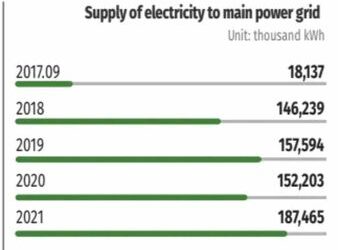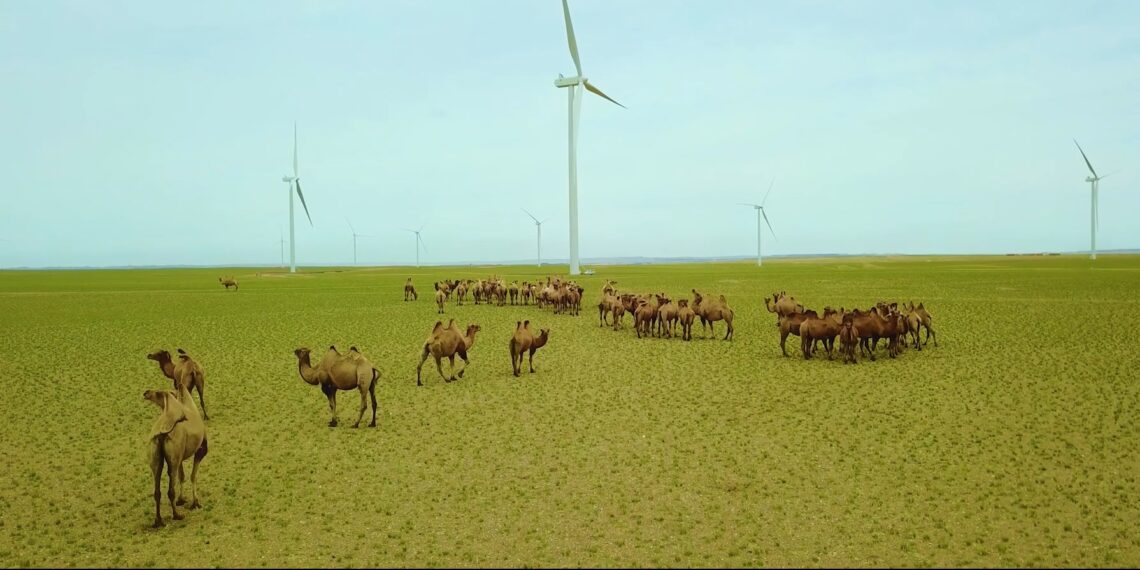According to the International Renewable Energy Agency (IRENA), countries around the world produced 2,179 GW of renewable energy, which is more than coal-fired power stations generated. Central Asia’s renewable energy production has doubled in the last five years, reaching 918 GW in 2017. In 2017, a year of rapid growth in renewable energy around the world, Mongolia increased its renewable energy capacity by 50 MW for the first time by generating electricity using winds from the Gobi and supplying it to the Central Region’s integrated power grid.
This major development was carried out by ‘Clean energy Asia’ LLC and its shareholder ‘Newcom’ LLC, a subsidiary of the ‘Softbank’ Corporation of Japan, ‘SB energy’, European Bank for Reconstruction and Development, and the Japan International Cooperation Agency (JICA). In 2008, a detailed study of wind resources was undertaken in Tsogttsetsii soum, Umnugobi province. A six-year study found that at an altitude of 80 meters, the average wind speed is 8.4 meters per second, which has great potential to generate renewable energy. With this amount of wind resources, it is possible to build wind farms with a capacity of up to 250 MW.
Clean Energy Asia LLC would like to invest a total of 128 million USD in a 50 MW wind farm project in the South Gobi, and in September 2016, it signed a financing agreement with the investor parties: European Bank for Reconstruction and Development and the Japan International Cooperation Agency (JICA) to begin the construction. The company completed the ‘Tsetsii’ wind farm three months ahead of schedule. About 500 people were employed during the construction, 95 percent of whom were Mongolians.
The international average time to build a wind farm is 1-1.5 years, while the ‘Tsetsii’ wind farm was built in an even shorter period of time. In particular, construction began in November 2016 and was completed by August of the following year, and in September more than 32 km of overhead transmission lines, substations, and wind turbines were commissioned and connected to the central regional power grid. With his development, Clean Energy Asia LLC has demonstrated that Mongolia’s renewable energy sector has limitless potential, including sufficient wind resources in the Gobi Desert for the international community. It has also demonstrated the importance of the role of the private sector in the development of the energy sector.

The Tsetsii wind farm has a capacity to produce 218.4 million KW of electricity annually. In other words, it is possible to supply electricity to about 100,000 households. From 2017 to today, the Tsetsii wind farm has been supplying 2-3% of the total consumption of the Central Region’s integrated energy network. It should be emphasized that the amount of energy imported from Russia declined by that amount. Newcom group, the company’s investor, first built the 50 MW Salkhit wind farm in Sergelen soum, Tuv province, and is the largest private “green” power producer, having commissioned the Tsetsii 50 MW wind farm in Tsogttsetsii in late 2017.
Since the commissioning of the Tsetsii wind farm, a total of 600,000 tons of greenhouse gases have been reduced, saving 1 million tons of coal and 5 million liters of water. If a coal-fired power plant with the same capacity was built, it would emit 600,000 tons of greenhouse gases, burn 1 million tons of coal and use 5 million tons of water in 2 years and 3 months to generate the same electricity and heat. As part of its social responsibility, Clean Energy Asia LLC implements a number of environmentally friendly projects and programs in partnership with Umnugovi province’s Environmental Protection Agency. For example, five students from low-income families in Siirst Bag, Tsogttsetsii soum, are awarded annual scholarships, and regular campaigns are conducted to provide fodder for the winter and to promote public health. At a time when the use of renewable energy is setting a new global trend, Clean Energy Asia LLC’s team is optimistic about the future.
Therefore, in recent years, they have turned their attention to major international ambitions and long-term goals, such as joining the Asian super grid and exporting energy. The purpose of the Asian super grid is to connect the power systems of Asian countries and share the vast resources of renewable energy. In our country, the starting point of this is the Tsetsii wind farm. During the winter peak load in the energy sector, the Tsetsii wind farm supplied a total of 661.6 million KWh of electricity to the central region’s grid, supplying about 73,500 households annually for 4 years and 3 months. Electricity consumption increased significantly in 2021 due to the government’s decision to reduce electricity bills. At the peak of the evening of December 17, 2021 (1,387 MW), wind farms generated 90 MW or 6.5 percent of total consumption. Another advantage of this wind farm is that it can be expanded to 250 MW based on the growth of electricity demand. In case it is extended to this extent, it will generate 1,092 million KWh of electricity and provide 400,000 households with “green” energy from inexhaustible natural resources.







